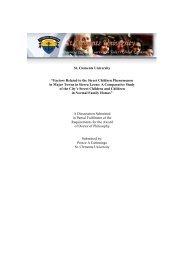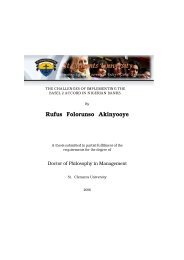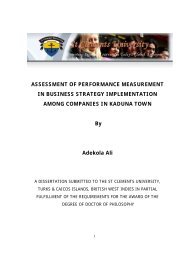The role of informal microfinance institutions in saving
The role of informal microfinance institutions in saving
The role of informal microfinance institutions in saving
You also want an ePaper? Increase the reach of your titles
YUMPU automatically turns print PDFs into web optimized ePapers that Google loves.
among variables such as the support measures and the end users, <strong>in</strong> this case, the SACCOs. <strong>The</strong><br />
research environment was the field conditions which were the operat<strong>in</strong>g environment <strong>of</strong> the<br />
various subsystems identified <strong>in</strong> the conceptual model.<br />
Two survey methods <strong>in</strong>clud<strong>in</strong>g questionnaires and <strong>in</strong>terviews were used because the<br />
respondents have diverse background. Interviews were used to obta<strong>in</strong> <strong>in</strong>formation from<br />
SACCO’s managers, government <strong><strong>in</strong>stitutions</strong>, non-governmental organizations, bus<strong>in</strong>ess<br />
development service providers and <strong>in</strong>ternational organizations that provide support to<br />
SACCOs.<br />
Questionnaires were used to obta<strong>in</strong> <strong>in</strong>formation from commercial banks, development f<strong>in</strong>ance<br />
<strong><strong>in</strong>stitutions</strong>, research <strong><strong>in</strong>stitutions</strong> as well as owners <strong>of</strong> SACCOs. <strong>The</strong> limited number <strong>of</strong> bus<strong>in</strong>ess<br />
support <strong>in</strong>clud<strong>in</strong>g Chief Executives.<br />
<strong>The</strong> goal <strong>of</strong> a formal research design is to test the hypothesis or answer the research question<br />
posed (Cooper and Sch<strong>in</strong>dler, 2001). <strong>The</strong> research design therefore, expresses both the<br />
structure <strong>of</strong> the research problem and the plan <strong>of</strong> <strong>in</strong>vestigation used to obta<strong>in</strong> empirical<br />
evidence on relations <strong>of</strong> the problem (Dem<strong>in</strong>g, 1960).<br />
3.1.3: Structure <strong>of</strong> Questionnaire<br />
<strong>The</strong> questionnaire is recognized as an important method <strong>of</strong> quantitative data collection and<br />
therefore, attempt was made to design it <strong>in</strong> a way as to capture accurate data and high<br />
response rate. In design<strong>in</strong>g the questionnaire, it was assumed that the respondents who are<br />
major stakeholders <strong>in</strong> provid<strong>in</strong>g supports to SACCOs as well as the beneficiaries (i.e. SACCOs<br />
themselves). Were sufficiently <strong>in</strong>formed on the subject matter.<br />
<strong>The</strong> questionnaire was therefore designed <strong>in</strong> such way as to elicit responses from scientists and<br />
researchers <strong>in</strong> public research and development <strong><strong>in</strong>stitutions</strong>, senior personnel <strong>in</strong> the bank<strong>in</strong>g<br />
<strong>in</strong>dustry and managers and owner’s <strong>of</strong> SACCOs.<br />
155
















